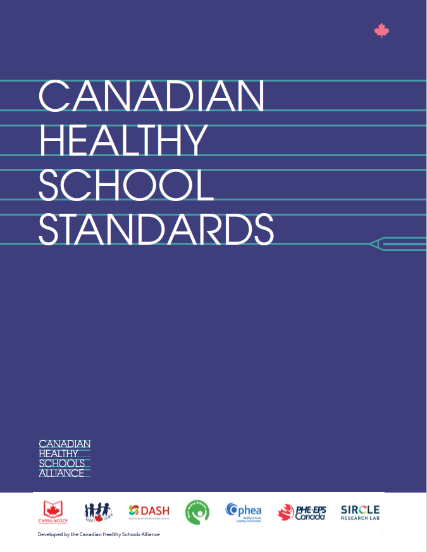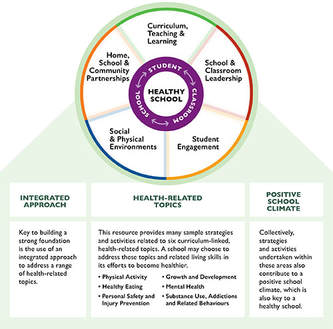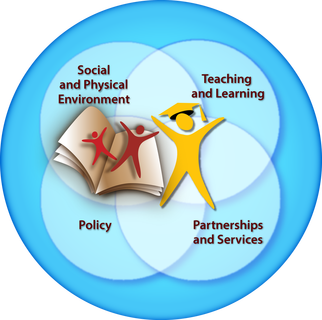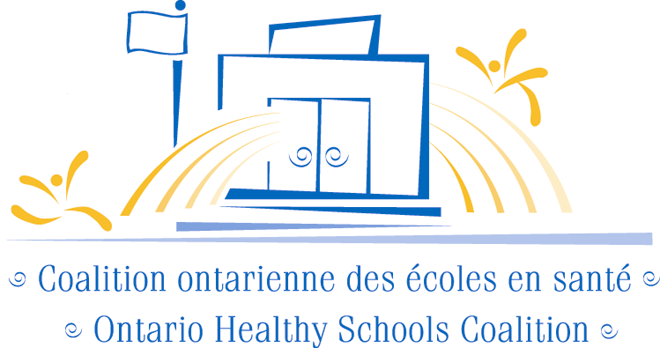Healthy Schools
Definition of a Healthy School and a Healthy Schools Approach (updated May 6, 2022)
Comprehensive approaches to school-based health promotion are known under a variety of names, such as Comprehensive School Health, Health Promoting Schools, Coordinated/Comprehensive School Health Program, Quality School Health, Healthy Active School Communities, and Living Schools. The Ontario Healthy Schools Coalition uses the term “Healthy Schools” as it conveys the common underlying theme. It is a straightforward phrase for use with all audiences. The Ontario Healthy Schools Coalition [OHSC] has adapted the World Health Organization’s definition of “health”[i] and “health promoting schools”[ii] as well as Indigenous health models[iii],[iv] to arrive at the following definition: “A healthy school promotes the physical, mental, emotional, social and spiritual well-being of the whole school community. It constantly strengthens its capacity as a healthy setting for living, learning and working.”
The OHSC encourages schools to follow the process described for Ophea’s [Ontario Physical and Health Education Association] Healthy Schools Certification[v] (2021). It includes 4 steps:
The Ontario Healthy Schools Coalition further emphasizes that:
RESOURCES
World Health Organization [WHO] (2021). Health Promotion Glossary of Terms 2021.
Retrieved from: https://www.who.int/publications/i/item/9789240038349
WHO (2022). Health Promoting Schools. Retrieved from https://www.who.int/health-topics/health-promoting-schools#tab=tab_1
National Collaborating Centre for Aboriginal Health (2010). A Framework for Indigenous School Health: Foundations in Cultural Principles.
Retrieved from https://www.nccih.ca/docs/health/RPT-FrameworkIndigenousSchoolHealth-Tagalik-EN.pdf
[Toulouse, P. (2016). What Matters in Indigenous Education: Implementing a Vision Committed to Holism, Diversity and Engagement. In Measuring What Matters, People for Education. Toronto: March, 2016. Retrieved from https://peopleforeducation.ca/wp-content/uploads/2017/07/MWM-What-Matters-in-Indigenous-Education.pdf
Ophea [Ontario Physical and Health Education Association] (2021). Healthy Schools Certification. Retrieved from https://www.ophea.net/healthy-schools-certification/4-step-healthy-schools-process
Ontario Ministry of Education (2014). Foundations for a Healthy School.
Retrieved from http://www.edu.gov.on.ca/eng/healthyschools/foundations.html
Canadian Healthy Schools Alliance (2021). Canadian Healthy School Standards.
Retrieved from https://static1.squarespace.com/static/5fa5d3a995cc5537744e8b52/t/60f1aab61673b2086a3ba52b/1626450621787/2021.07.16+CHSS_Final+v2-EN.pdf
Pan-Canadian Joint Consortium for School Health (2016).
What is Comprehensive School Health? Retrieved from http://www.jcsh-cces.ca/en/concepts/comprehensive-school-health/
Ontario Ministry of Health and Long-Term Care (2018). School Health Guideline.
Retrieved from http://www.health.gov.on.ca/en/pro/programs/publichealth/oph_standards/docs/protocols_guidelines/School_Health_Guideline_2018.pdf
Canadian Association for School Health & Others (2007). Canadian Consensus Statement on Comprehensive School Health (Revised Edition),CASH and 36 Canadian organizations, Surrey, BC.
Retrieved from https://drive.google.com/file/d/0B76Y7Zl6A-eBLUE0Ykh0VjduS00/view?resourcekey=0-6Imm9tpGLnHmRN9NbeG44Q
This list was derived from values, principles and components named in the above references as well as by the European Network of Health Promoting Schools, Schools for Health in Europe, the WHO Health Promoting Schools definition, Physical and Health Education Canada’s Model for a Healthy School Community, and the Ottawa Charter for Health Promotion Promotion.
Definition of a Healthy School and a Healthy Schools Approach (updated May 6, 2022)
Comprehensive approaches to school-based health promotion are known under a variety of names, such as Comprehensive School Health, Health Promoting Schools, Coordinated/Comprehensive School Health Program, Quality School Health, Healthy Active School Communities, and Living Schools. The Ontario Healthy Schools Coalition uses the term “Healthy Schools” as it conveys the common underlying theme. It is a straightforward phrase for use with all audiences. The Ontario Healthy Schools Coalition [OHSC] has adapted the World Health Organization’s definition of “health”[i] and “health promoting schools”[ii] as well as Indigenous health models[iii],[iv] to arrive at the following definition: “A healthy school promotes the physical, mental, emotional, social and spiritual well-being of the whole school community. It constantly strengthens its capacity as a healthy setting for living, learning and working.”
The OHSC encourages schools to follow the process described for Ophea’s [Ontario Physical and Health Education Association] Healthy Schools Certification[v] (2021). It includes 4 steps:
- Assemble Your Team
- Identify Your School Community Priorities, Assets and Health Topic(s)
- Develop Your Plan and Take Action
- Celebrate and Reflect
- Curriculum, Teaching & Learning
- School & Classroom Leadership
- Student Engagement
- Social & Physical Environments
- Home, School & Community Partnerships
The Ontario Healthy Schools Coalition further emphasizes that:
- Certain values are fundamental to the character and sustainability of Healthy Schools. These include: equity, inclusion, meaningful participation, collaboration and partnership building, empowerment, democracy, holistic health, life-long learning, healthy, sustainable environments and communities, and evidence-informed decision-making and evaluation.
- The aim of healthy schools is to promote the holistic development of young people.
- Healthy schools are characterized by grassroots partnership building involving school staff (administration, teachers, non-teaching staff), students, parents, and community agencies.
- A healthy school is underpinned by broad commitment to an evolving shared vision of a safe, healthy and caring school community for students, staff, and families. Commitment and dedicated resources to work towards achieving this vision are necessary at the provincial (inter-ministerial), regional (school board), and local (school) levels, for optimal sustainability.
- Healthy schools promote empowerment of youth and active participation of all partners, including students, in consensus-building and democratic decision-making.
- Healthy schools require structures (e.g. existing or new committees and designated coordinator) and processes (taking a proactive, strengths-based approach through visioning, assessing school strengths and needs, prioritizing, planning using the Foundations for a Healthy School framework, implementing, evaluating, celebrating) to identify and address health-related issues in an ongoing, sustainable way, as part of school improvement planning.
- To build and maintain a Healthy School, it is very important to seek broad agreement on, and implement health-supporting policies and guidelines.
- High quality instruction should use active learning approaches and at a minimum involve physical and health education from kindergarten to grade 12 as well as cross-curricular reinforcement of health concepts.
- Education and training of teachers and others in the healthy schools concept and approach is critical.
- Healthy Schools provide increased access to health and other support services such as guidance, social services, psychology services, child protection, etc.
- A supportive social environment is marked by a positive school climate or culture with healthy relationships created through such activities as peer support initiatives, parent or family involvement, role-modelling, community, media, and governmental support, school clubs and intramural teams, recess initiatives, etc.
- A healthy physical environment can be created through attention to areas such as play structures, air, water, equipment, cleanliness and hygiene, safe food handling, healthy food choices, universal breakfast, lunch or snack programs, enforcement of non-smoking on school property, fostering connections to nature and the environment, etc.
- Healthy Schools focus on protective factors/ developmental assets/ resiliency
- Healthy Schools use culturally-appropriate approaches and contribute to reducing health inequities and addressing many determinants of health, such as: income and social status; social support networks; education and literacy; employment/working conditions; social and physical environments; personal health practices and coping skills; healthy child development; access to health services; etc.
- Healthy schools promote a healthy, active, balanced life, which can enhance student learning
RESOURCES
World Health Organization [WHO] (2021). Health Promotion Glossary of Terms 2021.
Retrieved from: https://www.who.int/publications/i/item/9789240038349
WHO (2022). Health Promoting Schools. Retrieved from https://www.who.int/health-topics/health-promoting-schools#tab=tab_1
National Collaborating Centre for Aboriginal Health (2010). A Framework for Indigenous School Health: Foundations in Cultural Principles.
Retrieved from https://www.nccih.ca/docs/health/RPT-FrameworkIndigenousSchoolHealth-Tagalik-EN.pdf
[Toulouse, P. (2016). What Matters in Indigenous Education: Implementing a Vision Committed to Holism, Diversity and Engagement. In Measuring What Matters, People for Education. Toronto: March, 2016. Retrieved from https://peopleforeducation.ca/wp-content/uploads/2017/07/MWM-What-Matters-in-Indigenous-Education.pdf
Ophea [Ontario Physical and Health Education Association] (2021). Healthy Schools Certification. Retrieved from https://www.ophea.net/healthy-schools-certification/4-step-healthy-schools-process
Ontario Ministry of Education (2014). Foundations for a Healthy School.
Retrieved from http://www.edu.gov.on.ca/eng/healthyschools/foundations.html
Canadian Healthy Schools Alliance (2021). Canadian Healthy School Standards.
Retrieved from https://static1.squarespace.com/static/5fa5d3a995cc5537744e8b52/t/60f1aab61673b2086a3ba52b/1626450621787/2021.07.16+CHSS_Final+v2-EN.pdf
Pan-Canadian Joint Consortium for School Health (2016).
What is Comprehensive School Health? Retrieved from http://www.jcsh-cces.ca/en/concepts/comprehensive-school-health/
Ontario Ministry of Health and Long-Term Care (2018). School Health Guideline.
Retrieved from http://www.health.gov.on.ca/en/pro/programs/publichealth/oph_standards/docs/protocols_guidelines/School_Health_Guideline_2018.pdf
Canadian Association for School Health & Others (2007). Canadian Consensus Statement on Comprehensive School Health (Revised Edition),CASH and 36 Canadian organizations, Surrey, BC.
Retrieved from https://drive.google.com/file/d/0B76Y7Zl6A-eBLUE0Ykh0VjduS00/view?resourcekey=0-6Imm9tpGLnHmRN9NbeG44Q
This list was derived from values, principles and components named in the above references as well as by the European Network of Health Promoting Schools, Schools for Health in Europe, the WHO Health Promoting Schools definition, Physical and Health Education Canada’s Model for a Healthy School Community, and the Ottawa Charter for Health Promotion Promotion.

Schools Cannot Do It Alone
Presentation - 2019 ETFO Conference
LINK: Presentation Slides
THE PRESENTER ...As the Mental Health and Wellbeing Systems Lead for the St. Clair Catholic District School Board and Chair of the Ontario Healthy Schools Coalition (2021). Christine Preece has more than 25 years of experience in the both the education and health sectors. Chris spoke to the benefits of stronger and more effective links between education and health partners for the benefit of both students and staff in our school boards. The work of the Ontario Healthy Schools Coalition (OHSC) [9] was highlighted as an example of advocacy and support for healthy school communities.
Key Ideas
- Schools cannot deal with issues such as violence and mental health on their own
- Adopt an interconnected systems approach to the issues of school violence and mental health. Engage supports between ministries, public health, school boards, agencies, organizations, services, students and families.
- Addressing health disparities must be part of our education and social reform.
- Include the social determinants of health when considering root causes.
- Exposure to adversity can activate the child’s stress response with long-term health consequences.
- Screen for Adverse Childhood Experiences with supports for early intervention and cross-sector, coordinated care.
- Student mental health is a big challenge for twenty-first century learning (Kaylee Kyle, student trustee).
- Break the stigma of student mental health through advocacy and engaging student leaders.
- We need to advocate together rather than against each other
- Business, government, media, communities, families, municipalities, and social and health services need to support education in their work.

Wellbeing is Essential to Learning
The new Canadian Healthy School Standards have just been released! These Standards can help empower schools to become Healthy Schools and address a range of priorities through one proven approach.
Use the Standards to catalyze leadership and action on
The Standards and related tools are available at healthyschoolsalliance.ca. Get familiar with the Standards this summer, reflect on how you can kickstart action from within your role, join the conversation on Twitter @cdnschoolhealth, and join other school communities as we come together to transform learning spaces!
Let’s work together to make every school in Canada a Healthy School.
The new Canadian Healthy School Standards have just been released! These Standards can help empower schools to become Healthy Schools and address a range of priorities through one proven approach.
Use the Standards to catalyze leadership and action on
- Elevating student and staff wellbeing
- Increasing student success
- Acting on truth and reconciliation
- Embedding equity, diversity and inclusion
- Engaging school communities to move from one-off health-related activities towards a comprehensive, system-wide approach to creating an environment that supports wellbeing
The Standards and related tools are available at healthyschoolsalliance.ca. Get familiar with the Standards this summer, reflect on how you can kickstart action from within your role, join the conversation on Twitter @cdnschoolhealth, and join other school communities as we come together to transform learning spaces!
Let’s work together to make every school in Canada a Healthy School.
healthy schools resources
|
Ontario Ministry of Education
The Foundations for a Healthy School resource is designed to help contribute to a learning environment that promotes and supports child and student well-being. The completely revised Foundations for a Healthy School 2014 resource supports the integration of healthy schools policies, programs and initiatives into school and school board planning and implementation processes. |
|
Pan Canadian Joint Consortium for School Health (JCSH)
The Pan-Canadian Joint Consortium for School Health is a partnership of 25 Ministries of Health and Education across Canada working to promote a Comprehensive School Health approach to student wellness/well-being and achievement/success for all children and youth. Toolkits Positive Mental Health Toolkit Schools as a Setting for Positive Mental Health: Better Practices and Perspectives (2nd Edition) |
Vertical Divider
|
Community Health Nurses Initiatives Group The Community Health Nurses Initiatives Group (CHNIG) is pleased to announce the release of the paper Healthy Schools, Healthy Children: Maximizing the Contribution of Public Health Nursing in School Settings. The paper describes the critical issues in school health and articulates a scope of practice for public health nurses (PHNs) working within the school setting. It also contains a number of important recommendations that if implemented, will support the health of children and youth. Healthy Schools, Healthy Children: Maximizing the Contribution of Public Health Nursing in School Settings (Version 2) Evidence for School Public Health Nurses |



